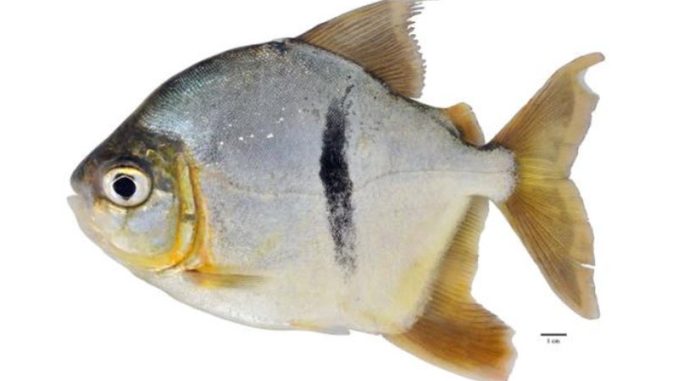
A newly described species of pacu found in the Amazon has been named after Sauron from “The Lord of the Rings” due to the striking vertical black bar on its side, which resembles the pupil of the fiery eye symbol associated with the villain. The scientific name of this species is thus Myloplus sauron.
Discovering Myloplus sauron
The Amazon River is home to around 2,500 named fish species, but researchers believe that nearly half of the aquatic life in this vast river system remains undiscovered. While studying piranhas and pacus to assess fish biodiversity in the 4,000-mile-long river, an international research team discovered Myloplus sauron, a plant-eating relative of piranhas with humanlike teeth.
This new species features striking orange and black markings, including a bold vertical black bar on its flank, which reminded researchers of Sauron’s eye from J.R.R. Tolkien’s “The Lord of the Rings.” This resemblance inspired the name Myloplus sauron, as noted in a study published in the journal Neotropical Ichthyology.
Inspiration Behind the Name
Victoria Pereira, a biology graduate student at the University of Paulista in São Paulo, Brazil, and coauthor of the study, said, “We thought the name would be a nice idea—it really looks like Sauron’s eye.” The researchers hoped that this pop culture reference would draw attention to the fish and efforts to protect Amazonian biodiversity.
“As soon as one of my colleagues came up with the name for this fish, we knew it was perfect for it,” said Dr Rupert Collins, Senior Curator of Fishes at the Natural History Museum in London, and one of the scientists who helped describe the species. “Its pattern looks a lot like the Eye of Sauron, especially with the orange patches on its body. With so much undescribed biodiversity in the Amazon and surrounding rivers, its name is also a good reminder to keep an eye out for undescribed species in South America.”
M. sauron isn’t the only creature named after Tolkien’s Dark Lord. A genus of butterflies discovered in May 2023 features spots resembling eyes on its wings, evoking the same symbol. There is also a tree frog, a dung beetle, and a genus of dinosaurs named after Sauron.
Myloplus aylan – a close relative of M. sauron
In addition to M. sauron, researchers also identified Myloplus aylan, which has a slightly thicker black bar on its side. Both species belong to the Serrasalmidae family, which includes piranhas and pacus. Differentiating between these closely related species can be challenging due to their similar features and the variations in appearance throughout their life stages.
The Importance of Discovery and Conservation
Matthew Kolmann, an assistant professor in the department of biology at the University of Louisville, emphasized the ongoing nature of discovering new species in the vast and inaccessible Amazon basin. “It will continue to take generations of scientists’ effort to increase our knowledge of the area,” Kolmann said. He highlighted the importance of inventorying species for future conservation efforts, especially as the Amazon faces significant habitat destruction threats.
In summary, the discovery and naming of Myloplus sauron not only add to our understanding of Amazonian biodiversity but also underscore the critical need for continued research and conservation efforts in this rich yet vulnerable ecosystem.
About Pacus
Pacu is a common name used for various species of South American serrasalmid fish related to the piranhas. The name pacu is of Tupi-Guaraní origin.
Pacus and piranhas both have strong jaws, but the piranhas are omniovres that feed chiefly on other fish, whilet the pacus feed mainly on plant material supplemented with some animal matter. The piranhas have pointed and very sharp teeth and a pronounced underbite, while the pacus have teeth that are more square and straight, and either a slight overbite or just a little bit of a underbite. The largest pacus are much bigger than the largest piranhas, as they can exceed one metre in length and weigh around 40 kg.
Pacus are native to both tropical and subtropical parts of South America and are found in a variety of habitats. They live in rivers, floodplains, lakes, and flooded forests in the Amazon, Orinoco, São Francisco, and Río de la Plata Basins, as well as rivers in the Guianas. Some of the species are migratory.
Many pacus play a crucial role in their ecosystem by spreading seeds through their fruit-heavy diet. This seed dispersal is vital for the growth of rainforest trees and other plants, helping to expand the forest and reduce disease spread among crowded trees. By cataloging species like Myloplus sauron and Myloplus aylan, researchers can better lead conservation efforts to protect endangered animals, particularly in habitats threatened by destruction.
Important food fish
In the Amazon, the pacus are very important food fishes, especially Colossoma macropomum, Piaractus brachypomus, and some members of the genus Mylossoma. Just as with many other fish in the Amazon river, they are currently at risk of being overfished. They are not only eaten locally; they are fished commercially as their sweet, mild flavour fetch a good price in markets in various parts South America.
Certain species of Pacu are today being farmed; not just in South America but also in other parts of the world where the climate is suitable. These fishes are pretty good at handling low-oxygen waters and do not need to be fed with expensive aimal-based foods, making them popular for fish farming. One example of a commonly farmed pacus is Piaractus mesopotamicus, also known as the Paraná River pacu.
Are pacus testicle biters?
In 2013, a pacu was caught in a strait between Sweden and Denmar, prompting local news to report about this exotic South American visitor. Some media outlets warned that pacus would attack testicles – a myth that started out as a joke referring to the pacus´ true fondness of devouring tree nuts. While pacus are not known to specifically go for testicles, they do have very strong jaws and are capable of crushing plant seeds and nuts.
